初级中学英语语法疑问句和感叹句
- 格式:doc
- 大小:247.00 KB
- 文档页数:21

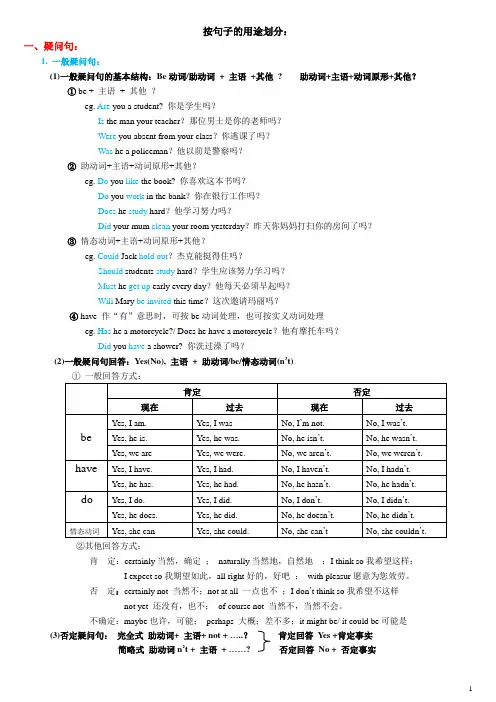
按句子的用途划分:一、疑问句:1. 一般疑问句:(1)一般疑问句的基本结构:Be动词/助动词+ 主语+其他? 助动词+主语+动词原形+其他?①be + 主语+ 其他?eg. Are you a student? 你是学生吗?Is the man your teacher?那位男士是你的老师吗?Were you absent from your class?你逃课了吗?Was he a policeman?他以前是警察吗?②助动词+主语+动词原形+其他?eg. Do you like the book? 你喜欢这本书吗?Do you work in the bank?你在银行工作吗?Does he study hard?他学习努力吗?Did your mum clean your room yesterday?昨天你妈妈打扫你的房间了吗?③情态动词+主语+动词原形+其他?eg. Could Jack hold out?杰克能挺得住吗?Should students study hard?学生应该努力学习吗?Must he get up early every day?他每天必须早起吗?Will Mary be invited this time?这次邀请玛丽吗?④have 作“有”意思时,可按be动词处理,也可按实义动词处理eg. Has he a motorcycle?/ Does he have a motorcycle?他有摩托车吗?Did you have a shower? 你洗过澡了吗?(2)一般疑问句回答:Yes(No), 主语+ 助动词/be/情态动词(n’t)②其他回答方式:肯定:certainly当然,确定;naturally当然地,自然地;I think so我希望这样;I expect so我期望如此,all right好的,好吧;with pleasur愿意为您效劳。
否定:certainly not 当然不;not at all 一点也不;I don’t think so我希望不这样not yet 还没有,也不;of course not 当然不,当然不会。

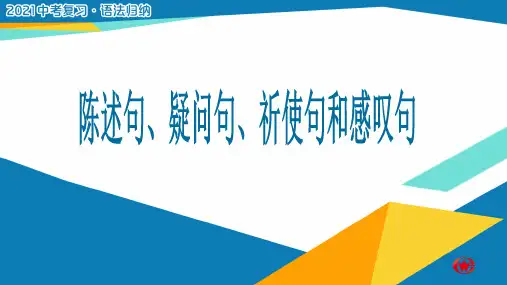
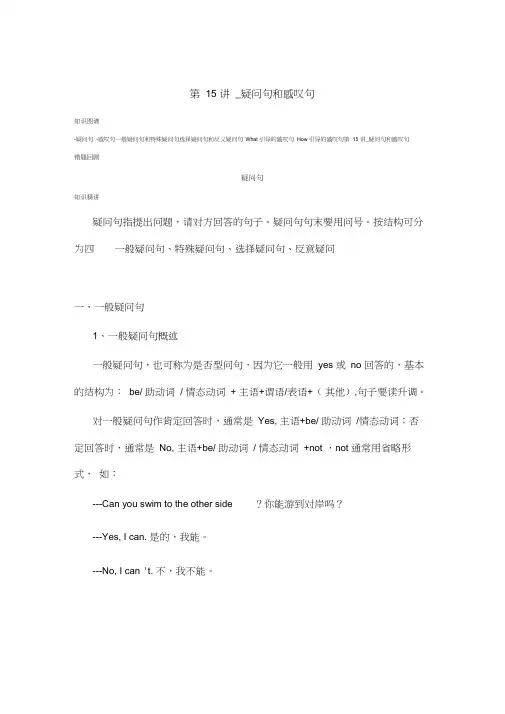
第15 讲_疑问句和感叹句知识图谱-疑问句-感叹句一般疑问句和特殊疑问句选择疑问句和反义疑问句What 引导的感叹句How 引导的感叹句第15 讲_疑问句和感叹句错题回顾疑问句知识精讲疑问句指提出问题,请对方回答的句子。
疑问句句末要用问号。
按结构可分为四一般疑问句、特殊疑问句、选择疑问句、反意疑问一、一般疑问句1、一般疑问句概述一般疑问句,也可称为是否型问句,因为它一般用yes 或no 回答的,基本的结构为:be/ 助动词/ 情态动词+ 主语+谓语/表语+(其他),句子要读升调。
对一般疑问句作肯定回答时,通常是Yes, 主语+be/ 助动词/情态动词;否定回答时,通常是No, 主语+be/ 助动词/ 情态动词+not ,not 通常用省略形式,如:---Can you swim to the other side ?你能游到对岸吗?---Yes, I can. 是的,我能。
---No, I can 't. 不,我不能。
注意:回答一般疑问句除了用yes 或no 外,也可用certainly ,probably ,perhaps ,of course ,all right ,with pleasure 等代替yes ,用never ,not at all 等代替no ,使得语气更加客气,委婉,如:---Can you help me? 你能帮个忙吗?---Certainly. 当然。
---Could you please make less noise? 你可以小声一点吗?---All right, sir. 好的,先生。
---Have you been there? 你到过那里吗?---Never. 从来没有。
二、特殊疑问句1. 特殊疑问句概述特殊疑问句多以who ,where ,when ,which ,whose ,why 这类词开头,其结构一般为:特殊疑问词+ 一般疑问句,即:特殊疑问词+be/ 助动词/ 情态动词+ 主语+ 谓语/表语+(其他),通常读降调,如:Who is it on the phone? 谁来的电话?How many oranges can you see in the picture?你能在图画上看到多少个橘子?2. 疑问副词三、选择疑问句选择疑问句一般提出两种或两种以上的可能,问对方选择哪一种。

(1)疑问句:用来提出疑问的句子。
可以分为:一般疑问句、特殊疑问句、选择疑问句和反意疑问句四种类型。
1)一般疑问句:能够用Yes或者No来回答的疑问句叫一般疑问句。
肯定回答用Yes,否定回答用No。
一般疑问句的结构是:Be+主语+表语+……?或者是:助动词/情态动词+主语+谓语+……?例如:-Are you a teacher? 你是老师吗?-Yes, I am. 是的,我是。
或:-No, I am not. 不,我不是。
—Does your mother go shopping on Sunday? 你妈妈星期天购物吗?-Yes, she does. 是的,她经常去购物。
或:-No, she doesn’t.不,她不经常去购物。
—Must we go at once? 我们必须立刻走吗?—Yes, we must. 是的,必须走。
或:—No, we needn’t. 不,没有必要。
注意:一般疑问句也可用表示肯定或否定的词来回答,如certainly(当然),surely(当然),of course(当然),I think so(我想是的),all right(好吧),certainly not(当然不是), not at all(一点也不), never(从不),sorry(很抱歉),not yet(还没有) I’m afraid not(恐怕不是)等。
2) 特殊疑问句:用来对句子的某一特殊部分提问的句子叫特殊疑问句。
特殊疑问句一般用降调。
其结构是:特殊疑问词+一般疑问句(+……)?对它的回答不能用Yes或者No,要根据询问的内容具体回答。
例如:-Where were you at that time? 那时你在哪里?—I was at home. 我在家。
常用的疑问代词有who(谁),whom(谁),whose(谁的),which(哪一个),what(什么);疑问副词有when(何时),where(何地),why(为什么),how(如何)以及“how+形容词”构成的短语。

(1)疑问句:用来提出疑问的句子。
可以分为:一般疑问句、特殊疑问句、选择疑问句和反意疑问句四种类型。
1)一般疑问句:能够用Yes或者No来回答的疑问句叫一般疑问句。
肯定回答用Yes,否定回答用No。
一般疑问句的结构是:Be+主语+表语+……?或者是:助动词/情态动词+主语+谓语+……?例如:-Are you a teacher? 你是老师吗?-Yes, I am. 是的,我是。
或:-No, I am not. 不,我不是。
—Does your mother go shopping on Sunday? 你妈妈星期天购物吗?-Yes, she does. 是的,她经常去购物。
不,她不经常去购物。
或:-No, she doesn’t.—Must we go at once? 我们必须立刻走吗?—Yes, we must. 是的,必须走。
或:—No, we needn’t. 不,没有必要。
注意:一般疑问句也可用表示肯定或否定的词来回答,如certainly(当然),surely(当然),of course(当然),I think so(我想是的),all right(好吧),certainly not(当然不是), not at all(一点也不), never(从不),sorry(很抱歉),not yet(还没有) I’m afraid not(恐怕不是)等。
2) 特殊疑问句:用来对句子的某一特殊部分提问的句子叫特殊疑问句。
特殊疑问句一般用降调。
其结构是:特殊疑问词+一般疑问句(+……)?对它的回答不能用Yes或者No,要根据询问的内容具体回答。
例如:-Where were you at that time? 那时你在哪里?—I was at home. 我在家。
常用的疑问代词有who(谁),whom(谁),whose(谁的),which(哪一个),what(什么);疑问副词有when(何时),where(何地),why(为什么),how(如何)以及“how+形容词”构成的短语。
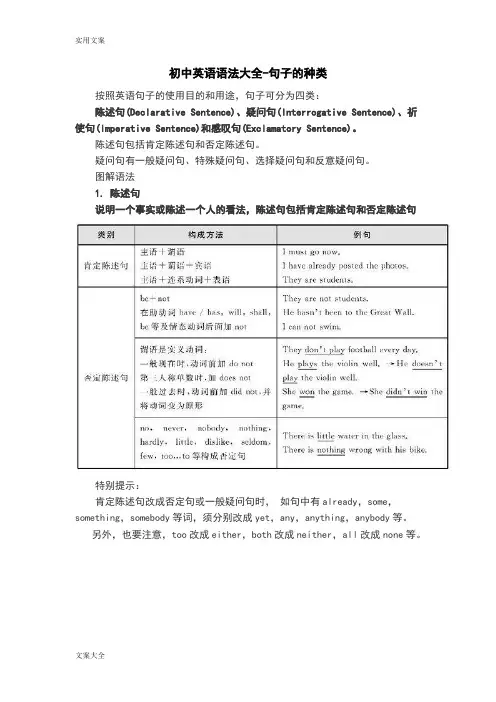
初中英语语法大全-句子的种类按照英语句子的使用目的和用途,句子可分为四类:陈述句(Declarative Sentence)、疑问句(Interrogative Sentence)、祈使句(Imperative Sentence)和感叹句(Exclamatory Sentence)。
陈述句包括肯定陈述句和否定陈述句。
疑问句有一般疑问句、特殊疑问句、选择疑问句和反意疑问句。
图解语法1. 陈述句说明一个事实或陈述一个人的看法,陈述句包括肯定陈述句和否定陈述句特别提示:肯定陈述句改成否定句或一般疑问句时,如句中有already,some,something,somebody等词,须分别改成yet,any,anything,anybody等。
另外,也要注意,too改成either,both改成neither,all改成none等。
2. 疑问句3. 常用的特殊疑问句4. 特殊的反意疑问句①主句是祈使句时,“will you?”意为“请求”,“won’t you?”表示提醒对方注意。
例句:Look at the blackboard, will you / won’t you?Don’t be late again, will you?②感叹句后的反意疑问,用一般现在时态的否定形式例句:What fine weather, isn’t it?How beautifully she sings, doesn’t she?③陈述部分是“I am …”时,用“aren’t I?”而不用“am not I?”例句:I'm working now, aren’t I?④陈述部分主语是everything,nothing,anything或something 时,疑问句主语用it例句:Something is wrong with my radio, isn’t it?Nothing is difficult, is it?⑤陈述部分的主语是somebody, nobody, everybody, anybody, no one,none, neither 时,疑问句的主语用they例句:Everyone is here, aren’t they?No one knows about it, do they?⑥陈述部分的主语是:1) this或that时,问句的主语用it2) these或those时,问句主语用they3) there be句时,反意疑问句中用there例句:This is a plane, isn’t it?These are grapes, aren’t they?There was a hospital here, wasn’t there?⑦陈述部分的主语是one时,问句的主语可用one,也可用you (美语用he)例句:One should be ready to help others, shouldn’t one?⑧陈述句中有few, seldom, never hardly,not,rarely,no,nobody,too…to等时,疑问句部分用肯定结构;如由前后缀构成否定词,疑问句部分仍用否定结构例句:He is never late for school, is he?You got nothing from him, did you?It is useless, isn’t it?⑨陈述部分主语是从句、不定式(短语)、动词-ing形式时,疑问句的主语用it例句:What you need is more important, isn’t it?⑩陈述部分由think, believe, suppose, imagine等引导的宾语从句:1) 主语是第一人称时,问句与从句的主谓语一致2) 主语是其他人称,问句与主句的主谓语一致例句:I think he will come, won’t he?I don’t think he can pass the exam, can he?He believed you had seen her before, didn’t he?? have是实义动词时,疑问句用助动词do,does,did;have 是助动词,则不然例如:They had a meeting just now, didn’t they?She’s been to many places of interest, hasn’t she?? 陈述部分有have /has /had to 时,疑问句要用助动词的否定形式例句:You have to water the vegetables now, don’t you?? 陈述部分有had better时,疑问句中用hadn’t刘局:We had better go to school at once, hadn’t we?? 陈述部分有must:1) 作“一定;必须”解释时,疑问句用mustn’t或needn’t;2) 表示推测,作“一定是;必定”解释时,疑问句需根据其后的动词原形选用相应的形式;3) 对过去动作推测时,问句的助动词用did或have;4) 对过去的状态推测时,问句的be用was例句:He must work hard at physics, mustn’t he?You must go to Guangzhou, needn’t you?You mustn’t smoke here, must you?Tom must be at home, isn’t he?She must have finished her work, hasn’t/didn’t she?He must have been a policeman, wasn’t he?? 陈述部分有ought to,used to,疑问句要用 shouldn’t,usedn’t / didn’t例句:Jill used to be a teacher, usedn’t / didn’t she?? 陈述句部分是复合句时,疑问句的主语和助动词要与主句一致例句:He was reading when the teacher came in, wasn’t he?特别提示:反意疑问句是“否定陈述句+肯定问句”时,如回答内容是肯定的,用“Yes+肯定结构”,反之,用“No+否定结构”。

初中英语语法大全-句子的种类按照英语句子的使用目的和用途,句子可分为四类:陈述句(Declarative Sentence)、疑问句(Interrogative Sentence)、祈使句(Imperative Sentence)和感叹句(Exclamatory Sentence)。
陈述句包括肯定陈述句和否定陈述句.疑问句有一般疑问句、特殊疑问句、选择疑问句和反意疑问句。
图解语法1。
陈述句说明一个事实或陈述一个人的看法,陈述句包括肯定陈述句和否定陈述句特别提示:肯定陈述句改成否定句或一般疑问句时,如句中有already,some,something,somebody等词,须分别改成yet,any,anything,anybody等。
另外,也要注意,too改成either,both改成neither,all改成none等。
2. 疑问句3. 常用的特殊疑问句4. 特殊的反意疑问句①主句是祈使句时,“will you?"意为“请求",“won't you?”表示提醒对方注意。
例句:Look at the blackboard, will you / won’t you?Don’t be late again, will you?②感叹句后的反意疑问,用一般现在时态的否定形式例句:What fine weather, isn’t it?How beautifully she sings, doesn’t she?③陈述部分是“I am …”时,用“aren’t I?"而不用“am not I?”例句:I'm working now, aren’t I?④陈述部分主语是everything,nothing,anything或something 时,疑问句主语用it例句:Something is wrong with my radio, isn’t it?Nothing is difficult, is it?⑤陈述部分的主语是somebody, nobody, everybody, anybody, no one, none, neither 时,疑问句的主语用they例句:Everyone is here, aren't they?No one knows about it, do they?⑥陈述部分的主语是:1) this或that时,问句的主语用it2) these或those时,问句主语用they3) there be句时,反意疑问句中用there例句:This is a plane, isn’t it?These are grapes, aren’t they?There was a hospital here, wasn’t there?⑦陈述部分的主语是one时,问句的主语可用one,也可用you (美语用he)例句:One should be ready to help others, shouldn't one?⑧陈述句中有few, seldom, never hardly,not,rarely,no,nobody,too…to等时,疑问句部分用肯定结构;如由前后缀构成否定词,疑问句部分仍用否定结构例句:He is never late for school, is he?You got nothing from him, did you?It is useless, isn’t it?⑨陈述部分主语是从句、不定式(短语)、动词-ing形式时,疑问句的主语用it例句:What you need is more important, isn’t it?⑩陈述部分由think, believe, suppose, imagine等引导的宾语从句:1) 主语是第一人称时,问句与从句的主谓语一致2) 主语是其他人称,问句与主句的主谓语一致例句:I think he will come, won’t he?I don’t think he can pass the exam, can he?He believed you had seen her before, didn’t he?? have是实义动词时,疑问句用助动词do,does,did;have 是助动词,则不然例如:They had a meeting just now, didn’t they?She’s been to many places of interest, hasn't she??陈述部分有have /has /had to 时,疑问句要用助动词的否定形式例句:You have to water the vegetables now, don’t you?? 陈述部分有had better时,疑问句中用hadn’t刘局:We had better go to school at once, hadn’t we?? 陈述部分有must:1) 作“一定;必须”解释时,疑问句用mustn’t或needn’t;2) 表示推测,作“一定是;必定"解释时,疑问句需根据其后的动词原形选用相应的形式;3) 对过去动作推测时,问句的助动词用did或have;4) 对过去的状态推测时,问句的be用was例句:He must work hard at physics, mustn’t he?You must go to Guangzhou, needn’t you?You mustn’t smoke here, must you?Tom must be at home, isn’t he?She must have finished her work, hasn’t/didn’t she?He must have been a policeman, wasn’t he??陈述部分有ought to,used to,疑问句要用 shouldn’t,usedn’t / didn’t例句:Jill used to be a teacher, usedn’t / didn’t she??陈述句部分是复合句时,疑问句的主语和助动词要与主句一致例句:He was reading when the teacher came in, wasn't he?特别提示:反意疑问句是“否定陈述句+肯定问句”时,如回答内容是肯定的,用“Yes+肯定结构”,反之,用“No+否定结构”。
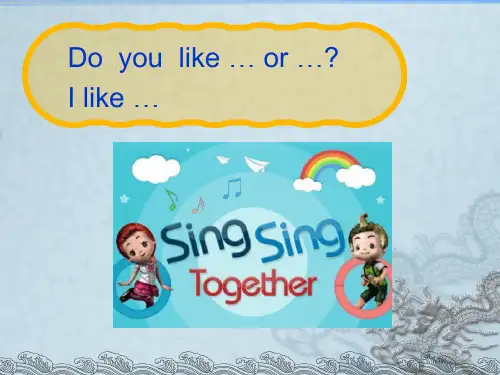
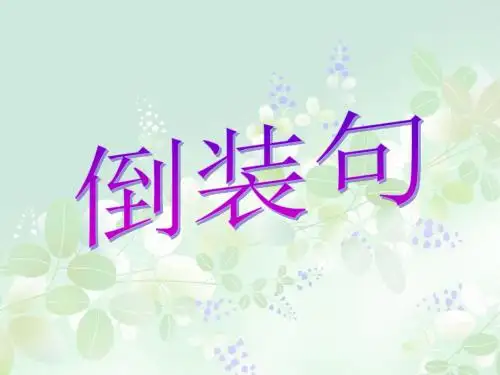
初中英语知识点汇总:陈述句、疑问句、祈使句、感叹句句子的类型(一)教学重点句子的类型:陈述句陈述句(包括肯定的或否定的)用来叙述一项事实。
陈述句的结构分为肯定结构和否定结构两种。
1、陈述句的肯定结构(1)主语与谓语的一致,句子中的谓语动词和主语在人称和数上必须一致。
如:I was having dinner when he came in.He is now working at a bank.①谓语只跟主语的中心词保持一致,修饰词不影响主语的数:The quality of this kind of bike is poor.There be结构和其他倒装句中,谓语通常放在主语的前面,这时谓语是单数还是复数,要依后面的主语而定,如:There is no milk in the bottle.There are no students iin the classroom.②“one of ……”结构作主语,谓语应该用单数。
如:One of the students is absent.Making things is a good activity.What hurt her most is his words.③由and连接两个或两个以上的名词,由“both…and…”连接的两个成分作主语,其谓语动词通常用复数形式,如:Susan and Sally like pop music.The worker and the peasant are going to give us a talk.④单数名词后面有下面词语修饰时,主语不受这些词或词组的影响with…. like…as well as…together with…He, as well as his classmates, likes popular songs.Mr Li, together with his wife and two songs, is on holiday these days.⑤由连词“either…or…”,“neither…nor…”,“not only…but also…”,also, nor, or连接两个名词或代词,谓语动词的形式应与最近的主语保持一致Neither I nor my brother is good at maths.Either you or I’m wrong.注意:表示数量、时间、距离、金钱等的复数名词作主语时,谓语动词一般用单数形式。
中考英语语法复习点:疑问句和感叹句(一)句子种类概述句子按种类可分为陈述句、疑问句、祈使句和感叹句。
(二)基础知识梳理1.疑问句疑问句就是提出问题,让对方作出回答。
英语中有四种疑问句,即一般疑问句、特殊疑问句、选择疑问句、反意疑问句。
1)一般疑问句用于询问一个事实是否属实,其回答通常是Yes或No。
其结构为:be,will,have,助动词+主语+(主动词)/宾语如:Is she a university teacher?Will it be windy tomorrow?Did he take part in the maths contest yesterday?2)特殊疑问句特殊疑问句对句中某一特定部分提问,以特殊疑问词开头根据实际情况,不必用Yes或No回答。
常见的特殊疑问词有what,who,whom,when,what,time,where,why,which,whose,how old,how many+可数名词复数,how much+不可数名词,how long,how far,how fast,how soon等。
其结构为:疑问句+一般疑问句语句如:Who has lunch fastest at school in our class?What are you doing now?How long have you lived here?3)选择疑问句选择疑问句通常提供两种或两种以上情况,询问对方选择哪一种。
回答时选择一种,不必用Yes或No。
一般疑问句+A or B如:Is there any coffee or water in the cup?Do you often play basketball or play the piano?特殊疑问句,A or B?或A,B or C?如:Which is the biggest, the moon, the earth or the sun?Which do you like better, the record or the ball?4)反意疑问句由两部分组成,前半句为陈述句,后半句是一个附着在前半句上的简短问句,回答时用Yes 或No。
广州卓越教育机构一对一初三英语语法---感叹句&反义疑问句感叹句感叹句通常有what, how引导,表示赞美、惊叹、喜悦、等感情。
what修饰名词,how 修饰形容词,副词或动词,感叹句结构主要有以下几种。
感叹句通常由what或how引导,一般各有三种情况:1.What引导的感叹句1)What+a(an)+形容词+可数名词的单数形式+主语+谓语!如:What a new watch it is! 多么新的一块手表啊!2)What+形容词+可数名词的复数形式+主语+谓语!如:What interesting books the children are reading!孩子们读的书多么有趣啊!3)What+形容词+不可数名词+主语+谓语!如:What important news it is! 多重要的新闻啊!2.How引导的感叹句1)How+形容词或副词+主语+谓语!如:How tall the girl is! 那个女孩多高啊!2)How+形容词+a(an)+可数名词的单数形式+主语+谓语!如:How heavy a box they are carrying! 他们抬的箱子多重啊!3)How+主语+谓语!如:How time flies!时间过得多快!特别提示:如何判断用what还是用how?方法一:凡是有a, an开头的,多用what!方法二:凡是形容词直接加名词多用what!方法三:其他一般用how。
感叹句的结构及特点总结感叹句并不难,how或what置句首。
名词之前用what,How后形副紧相连。
主谓次序不能变,口语省略倒常见。
二、把陈述句改为感叹句口诀陈改感叹并不难:What或How置句前,形、副紧跟how后,what(冠)要和形名连,主语谓语在句末,它们省略也常见。
三、感叹句解题四部曲(1)找谓语:先找谓语后定主语。
感叹句谓语动词或系动词位于句末,如果找不到就是省略了。
如:what a brave boy he is! How hard she studied!(2) 找主语:谓语动词前的名词或代词就是句子的主语,找到主语后,在主语前划线,把它与前面分离。
初中英语语法大全-句子的种类按照英语句子的使用目的和用途,句子可分为四类:陈述句(Declarative Sentence)、疑问句(Interrogative Sentence)、祈使句(Imperative Sentence)和感叹句(Exclamatory Sentence)。
陈述句包括肯定陈述句和否定陈述句。
疑问句有一般疑问句、特殊疑问句、选择疑问句和反意疑问句。
图解语法1. 陈述句说明一个事实或陈述一个人的看法,陈述句包括肯定陈述句和否定陈述句特别提示:肯定陈述句改成否定句或一般疑问句时,如句中有already,some,something,somebody等词,须分别改成yet,any,anything,anybody 等。
另外,也要注意,too改成either,both改成neither,all改成none等。
2. 疑问句3. 常用的特殊疑问句4. 特殊的反意疑问句①主句是祈使句时,“will you?”意为“请求”,“won’t you?”表示提醒对方注意。
例句:Look at the blackboard, will you / won’t you?Don’t be late again, will you?②感叹句后的反意疑问,用一般现在时态的否定形式例句:What fine weather, isn’t it?How beautifully she sings, doesn’t she?③陈述部分是“I am …”时,用“aren’t I?”而不用“am not I?”例句:I'm working now, aren’t I?④陈述部分主语是everything,nothing,anything或something 时,疑问句主语用it例句:Something is wrong with my radio, isn’t it?Nothing is difficult, is it?⑤陈述部分的主语是somebody,nobody,everybody,anybody,no one,none,neither 时,疑问句的主语用they例句:Everyone is here,aren’t they?No one knows about it,do they?⑥陈述部分的主语是:1) this或that时,问句的主语用it2) these或those时,问句主语用they3) there be句时,反意疑问句中用there例句:This is a plane, isn’t it?These are grapes, aren’t they?There was a hospital here, wasn’t there?⑦陈述部分的主语是one时,问句的主语可用one,也可用you (美语用he)例句:One should be ready to help others, shouldn’t one?⑧陈述句中有few,seldom,never hardly,not,rarely,no,nobody,too…to等时,疑问句部分用肯定结构;如由前后缀构成否定词,疑问句部分仍用否定结构例句:He is never late for school, is he?You got nothing from him, did you?It is useless, isn’t it?⑨陈述部分主语是从句、不定式(短语)、动词-ing形式时,疑问句的主语用it例句:What you need is more important,isn’t it?⑩陈述部分由think,believe,suppose,imagine等引导的宾语从句:1) 主语是第一人称时,问句与从句的主谓语一致2) 主语是其他人称,问句与主句的主谓语一致例句:I think he will come, won’t he?I don’t think he can pass the exam, can he?He believed you had seen her before, didn’t he?? have是实义动词时,疑问句用助动词do,does,did;have 是助动词,则不然例如:They had a meeting just now, didn’t they?She’s been to many places of interest, hasn’t she?? 陈述部分有have /has /had to 时,疑问句要用助动词的否定形式例句:You have to water the vegetables now, don’t you?? 陈述部分有had better时,疑问句中用hadn’t刘局:We had better go to school at once, hadn’t we?? 陈述部分有must:1) 作“一定;必须”解释时,疑问句用mustn’t或needn’t;2) 表示推测,作“一定是;必定”解释时,疑问句需根据其后的动词原形选用相应的形式;3) 对过去动作推测时,问句的助动词用did或have;4) 对过去的状态推测时,问句的be用was例句:He must work hard at physics, mustn’t he?You must go to Guangzhou, needn’t you?You mustn’t smoke here, must you?Tom must be at home, isn’t he?She must have finished her work, hasn’t/didn’t she?He must have been a policeman, wasn’t he?? 陈述部分有ought to,used to,疑问句要用shouldn’t,usedn’t / didn’t例句:Jill used to be a teacher, usedn’t / didn’t she?? 陈述句部分是复合句时,疑问句的主语和助动词要与主句一致例句:He was reading when the teacher came in, wasn’t he?特别提示:反意疑问句是“否定陈述句+肯定问句”时,如回答内容是肯定的,用“Yes+肯定结构”,反之,用“No+否定结构”。
初中英语知识点汇总:陈述句、疑问句、祈使句、感叹句句子的类型(一)教学重点句子的类型:陈述句陈述句(包括肯定的或否定的)用来叙述一项事实。
陈述句的结构分为肯定结构和否定结构两种。
1、陈述句的肯定结构(1)主语与谓语的一致,句子中的谓语动词和主语在人称和数上必须一致。
如:I was having dinner when he came in.He is now working at a bank.①谓语只跟主语的中心词保持一致,修饰词不影响主语的数:The quality of this kind of bike is poor.There be结构和其他倒装句中,谓语通常放在主语的前面,这时谓语是单数还是复数,要依后面的主语而定,如:There is no milk in the bottle.There are no students iin the classroom.②“one of ……”结构作主语,谓语应该用单数。
如:One of the students is absent.Making things is a good activity.What hurt her most is his words.③由and连接两个或两个以上的名词,由“both…and…”连接的两个成分作主语,其谓语动词通常用复数形式,如:Susan and Sally like pop music.The worker and the peasant are going to give us a talk.④单数名词后面有下面词语修饰时,主语不受这些词或词组的影响with…. like…as well as…together with…He, as well as his classmates, likes popular songs.Mr Li, together with his wife and two songs, is on holiday these days.⑤由连词“either…or…”,“neither…nor…”,“not only…but also…”,also, nor, or连接两个名词或代词,谓语动词的形式应与最近的主语保持一致Neither I nor my brother is good at maths.Either you or I’m wrong.注意:表示数量、时间、距离、金钱等的复数名词作主语时,谓语动词一般用单数形式。
知识图谱-疑问句-感叹句一般疑问句和特殊疑问句选择疑问句和反义疑问句What引导的感叹句How引导的感叹句第15讲_疑问句和感叹句错题回顾疑问句知识精讲疑问句指提出问题,请对方回答的句子。
疑问句句末要用问号。
按结构可分为四种:一般疑问句、特殊疑问句、选择疑问句、反意疑问句。
一、一般疑问句1、一般疑问句概述一般疑问句,也可称为是否型问句,因为它一般用yes或no回答的,基本的结构为:be/助动词/情态动词+主语+谓语/表语+(其他),句子要读升调。
对一般疑问句作肯定回答时,通常是Yes, 主语+be/助动词/情态动词;否定回答时,通常是No, 主语+be/助动词/情态动词+not,not通常用省略形式,如:---Can you swim to the other side?你能游到对岸吗?---Yes, I can. 是的,我能。
---No, I can’t. 不,我不能。
注意:回答一般疑问句除了用yes或no外,也可用certainly,probably,perhaps,of course,all right,with pleasure等代替yes,用never,not at all等代替no,使得语气更加客气,委婉,如:---Can you help me? 你能帮个忙吗?---Certainly. 当然。
---Could you please make less noise? 你可以小声一点吗?---All right, sir. 好的,先生。
---Have you been there? 你到过那里吗?---Never. 从来没有。
二、特殊疑问句1. 特殊疑问句概述特殊疑问句多以who,where,when,which,whose,why这类词开头,其结构一般为:特殊疑问词+一般疑问句,即:特殊疑问词+be/助动词/情态动词+主语+谓语/表语+(其他),通常读降调,如:Who is it on the phone? 谁来的电话?How many oranges can you see in the picture?你能在图画上看到多少个橘子?2. 疑问副词三、选择疑问句选择疑问句一般提出两种或两种以上的可能,问对方选择哪一种。
其结构可用一般疑问句,也可用特殊疑问句,供选择的两部分由or连接,前者用升调,后者用降调。
选择疑问句也分为一般选择疑问句和特殊选择疑问句,但回答不能用yes或no回答,都要用完整的句子。
1. 一般选择疑问句一般选择疑问句的结构为:一般疑问句+A or B?如:---Will you go there by bus or by train?---I will go by train.—你准备乘汽车,还是乘火车去那儿?—我会坐火车去。
2. 特殊选择疑问句特殊选择疑问句的结构为:特殊疑问句,+A or B?如:---What would you like, coffee or tea?---I would like coffee.—你想要什么,咖啡还是茶?—我想来点咖啡。
四、反意疑问句1. 反意疑问句的构成反意疑问句是一种常用于口语的疑问句,这种问句由两部分组成,前一部分是陈述句,后一部分是附加的一简短问句,中间用逗号隔开,因此,反意疑问句又称附加疑问句。
如果陈述句是肯定句,附加问句用否定句;如果陈述句是否定,附加问句用肯定句,即“前肯后否,前否后肯”。
附加问句一般为“be动词(助动词、情态动词)+代词”构成,如:They didn’t clean the classroom yesterday, did they?他们昨天没有扫扫教室,是吗?You’re coming, aren’t you?你会来的,不是吗?2. 反意疑问句的答语1).反意疑问句的答语一般由yes或no引导的简略答语来回答,但是要注意时态及代词的呼应,如:---She is your teacher, isn’t she? 她是你的老师,是吧?---Yes, she is. 是的,她是。
---No, she isn’t. 不,她不是。
2). 在前否定后肯定的句子中,yes含义为“不”,no含义为“是”,如:She can’t swim, can she? 她不会游泳,对吗?Yes, she can. 不,她会。
No, she can’t. 是的,她不会。
三点剖析一、考点及延伸:中考考查疑问句重点如下:特殊疑问句中疑问词的辨别和选择;反意疑问句的提问和回答;否定形式反意疑问句的回答的正确理解。
除了语法的考查,疑问句也常在各种文章中出现,能够正确理解疑问句,能很大程度地帮我们正确理解语言环境。
以下两点是疑问句考点延伸:1. 否定的特殊疑问句一般有劝告,建议,责备等意味,如:Why don’t you finish your homework?=Why not finish your homework?为什么不完成作业呢?2. 陈述句谓语动词是wish,表示征求意见时,反意问句用may,如:I wish to have another piece of cake, may I?我想再要一块蛋糕,可以吗?I wish to go home now, may I?我想现在就回家,可以吗?二、方法总结疑问句是考试中的高频考点,重点考查疑问词选择和反意疑问句。
疑问词的选择一般考查与介词的结合,比如how far, how long等一系列,重点区分各自含义和回答;反意疑问句考查较简单,只要遵循“前肯后否,前否后肯”原则即可,注意hardly, seldom, never等有否定含义的词的出现,视为否定句,疑问部分用肯定形式。
题模精讲题模一一般疑问句和特殊疑问句例1.1、---Are you sure you can do well in the final exam?---_________, I’ve got everything ready.A、N o, I’m not sureB、I t’s hard to say.C、Y es, I think soD、I hope not例1.2、---_________ is your father?---A.bank clerk. He works in a bank near my home.A、W hereB、H owC、W hatD、W hich例1.3、对划线部分提问。
________________________________________题模二选择疑问句和反义疑问句例2.1、_____________________________________________例2.2、---Is this a Chinese book or an English book?---Oh, _________A、y es, it is.B、n o, it isn’t.C、a n English book.D、a music book.例2.3、Tom can hardly do it well, _________?A、c an heB、c an’t heC、d oes heD、d oesn’t he例2.4、---Don’t smoke in the reading room, _________?---I’m sorry. I won’t do it again.A、w ill youB、s hall weC、d o youD、c an you随堂练习随练1.1、---Excuse me, can I use your pen?---_________. Here you are.A、Yes, of course.B、No, you can’t.C、You are welcome.D、It doesn’t matter.随练1.2、She usually does some housework on Sundays. (改为一般疑问句) _____________________________________________随练1.3、_____________________________________________随练1.4、---_________ is your father? Does he still work as an engineer?---Yes, he has been an engineer for thirty years.A、WhoB、HowC、WhatD、Which随练1.5、---_________ is the World Cup held ?---Every 4 years.A、How soonB、How manyC、How oftenD、How long随练1.6、--- Did you use to have straight or curly hair, Cindy?---_________. I like that hair style.A、Yes, I didB、Straight hairC、No, I didn’tD、Not curly hair随练1.7、I don’t think the newly directed film by Zhao Wei is as interesting as people say, _________?A、do IB、don’t IC、is itD、isn’t it随练1.8、Jim needn’t sing this song. (改为反意疑问句)_____________________________________________随练1.9、You need to wait for her. (改为反意疑问句)_____________________________________________感叹句知识精讲感叹句一般是用来表示说话时的喜悦、惊讶等情感。
英语感叹句常用“what”和“how”引导,“what”和“how”与所修饰的词置于句首,其它部分用陈述句语序。
一、由“what”引导的感叹句“what”意为“多么”用作定语,修饰名词(被强调部分),单数可数名词前要加不定冠词a/ an,复数可数名词或不可数名词前不用冠词。
总结其句子结构可分为以下三种:1. 可用句型:“What + a/ an+形容词+可数名词单数+主语+谓语!”。
如:What a nice present it is! 它是一件多么好的礼物啊!What an interesting book it is! 它是一本多么有趣的书啊!2. 可用句型:“What+形容词+可数名词复数+主语+谓语!”。